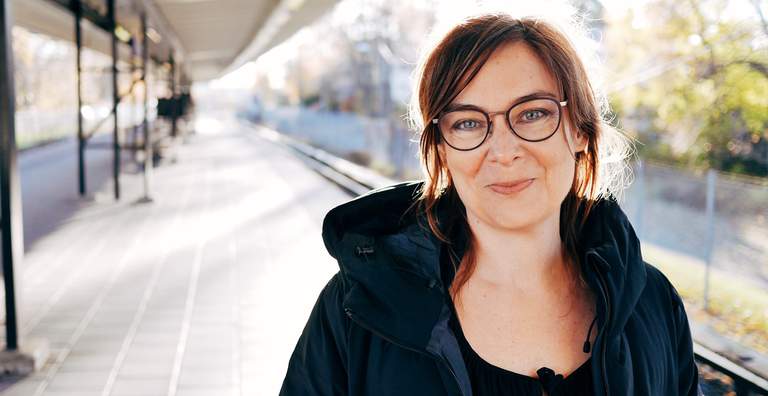An artist in the subway - Maria Miesenberger
Publish date: 21 April 2018
What's it like to make art for a subway station in Stockholm? We had a chat with artist Maria Miesenberger to find out.
Because Enskede Gård is one of the oldest stations (it welcomed its first passengers in 1951), it was left without artwork for a long time. It was built during a time when politicians were firm in their belief that metro stations should first and foremost be functional.
Eventually, opinions swayed, and when T-Centralen and Gamla Stan were constructed, they became the first stations that incorporated art. Since then every new station has been planned in conjunction with artists, and the subway’s older stations have over time been redecorated.
And when the Green line’s southeastern arm was being renovated in the early 2010s Enskede Gård finally got an artistic expression of its own: Maria Miesenberger’s "Moment in Motion/Ögonblick i rörelse". Both a photographer and sculptor, Maria has also created public art for Artipelag in Stockholm, the University of Växsjö, and the Konst på Hög sculpture park.
The piece is an installation in four parts. Most eye-catching are probably the two polished stainless-steel sculptures, seemingly frozen in mid-air. Maria wanted to soften the look and feel of cold steel which is why they’re covered in a dark webbed pattern, modeled after the nerves of the cornea. After all, it’s something that enables and protects eyesight, and the same pattern is repeated on the relief walls of dark granite covering the entrance hall staircase and sandblasted into concrete tiles out on the platform.
How did you get involved in creating Enskede Gård’s art?
"It actually started with a competition for Stureby station’s new art direction. I submitted an extensive draft, that I later was asked to remodel to suit Enskede Gård’s station instead. And since Enskede Gård is quite a small station I got the opportunity to fashion the whole station in great detail, which is uncommon for these old stations."
What was your thought process like when approaching the project?
"I started thinking about all the people passing through metro stations, but also that it’s probably the same people passing through every day. Especially on the stations in Stockholm’s surroundings. That’s why I wanted to create something that had longevity. A piece in which you every day could discover new details and that changes during the day, as light conditions change. I also wanted to create something that took into account the kind of place that Enskede Gård is. There’s a high school here, a church, stables… basically, it’s an area with people from all walks of life."
Tell us more about the sculptures, how did you approach them?
"The model was my nephew Daniel. I always use models that are actually someone near and dear to me. Even if the finished piece is androgynous and smooth-surfaced, it’s a portrait representing somebody that’s reached the point in life where it’s time to make an important decision, to choose a path, and to challenge yourself."
Are any of your nephew’s defining features apparent in the finished sculptures?
"Absolutely [laughing]. If he were here, you’d probably see some resemblance. Even if it's more of a general representation."
The statue out on the platform seems to be climbing on the ceiling. Why?
"Well, I call it "Moving On" and looking at it from one side you can see the figure having a firm, tense grip on the railing. Like when you stiffen up and hold your breath to hold on to something. But viewed from the other side the sculpture is relaxed and loose, with his arm and leg frozen in this fluid motion, free to take the next step. And I wanted to visualize those two aspects of everyday life. Sometimes you have to hold on, and other times you need the courage to just let go and move on. And moving around the sculpture you can see it change. The squatting sculpture over the staircase is "Taking Off". He’s ready to take the next step in life or embark on his next journey."
What are your thoughts on working with public art? This, after all, isn’t your first public piece.
"I think the public space is the best room to work in, because as an artist you want to communicate and the audience is always present in public spaces, as opposed to galleries and museums that have a more niche audience, and sometimes fewer visitors too. Other than that I don’t approach my public art any differently than my gallery pieces. But to define a whole room or place like this is important and gives you great opportunities as an artist."
Do you ever visit your public pieces to check up on them and see if they’re in good shape?
"Sure. And these are in pretty good shape, they don’t have any scribbles or scratches on them. They seem to be in good hands. The residents around the station were actually really involved in the whole renovation project. I got invited to show my sketches and explain my ideas, and when it was time for the unveiling they organized a party. They’ve really embraced my work on the station."
